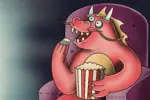There are two alternatives to large franchising of films in the mainstream entertainment industry: Art cinema and world cinema. The word “cinema” sparks the notion of “movies as art” to the audience. It’s not just entertainment anymore. So, if we can manipulate the audience like this, then we can achieve a more serious tone when it comes to watching movies. I believe that this understanding is important because I think films have the capacity to change the world.
They tell stories in a way that capture feelings and emotions waking you up like a hammer breaking a wall. Movies give you the possibility to travel through space and time, and what better way to do that than with some quality artistic movies. In this sense, we can do that by using tools such as Kanopy — an on-demand streaming video platform for public libraries and universities, offering both films and documentaries.
However, the popular belief in American society is that movies are mainly for entertainment. And the reality is that the film industry is geared towards generating profit. At least that has been the case in Hollywood since the end of World War II. Making movies can be extremely expensive: you rent equipment, pay staff, actors and directors to name a few.
If you compare this type of art-making with writing, writers only need a blank page to be filled with words. If you compare it with painting, painters only need a white canvas. And if you compare it with music, musicians only need to fill the silence. So, a film is a combination of all these arts and many more, and this means that by necessity, movies can also be more than just entertainment.
The idea that movies are entertainment has distorted the possibility of audience members examining films from the same viewpoint as you would when visiting a museum. And of course, this depends on the type of film that you are watching. If the type of movie is important, then it is relevant to see how they are being interpreted by the audience.
It’s important to mention that big blockbuster movies that are seen for their entertainment purposes can be art as well. For example, “Mad Max: Fury Road” by George Miller is a cinematic masterpiece. It is disguised as a blockbuster film because it has most of the qualities that a Hollywood blockbuster movie would obtain, but it is rich in everything. From well written story line to acting to breathtaking special effects, it is a movie that must be studied by anyone who is trying to get into film making or just a fan of the industry.
My experience with Kanopy has been fantastic. Yes, that is all I can say because you need to experience the movies for yourself. The beauty of having a library full of films is that you get to decide what to watch. There are no “recommended” or “popular series to watch” section — instead, there are different themes on the platform. This allows you to be curious and that’s important because in today’s society, we get lost in public opinion, leaving no room for originality. So, what is Kanopy like and what are some of the best movies to stream on the platform today?
“Breathless” (1960) by Jean-Luc Godard
This was the first movie I thought of watching. I was watching interviews on film directors by the Criterion Collection Channel — a company that focuses on licensing important classic and contemporary films and selling them to fans (also available for free on Kanopy). And so, some of the directors were referencing “Breathless” as a paradigm shift for cinema. They suggested the movie changed the industry forever and gave the blueprint for what we see in modern cinema today.
https://www.youtube.com/watch?v=SqOJaGM-wQg
If you watch “Breathless,” you can see that the movie is weird and different from any other Hollywood movie you’ve probably ever seen. This is because it is considered the face of the French New Wave. This “New Wave” is the consequence of desperation and the need for creativity and originality in the cinematic art form.
People were tired of the same structure in films: the hero, anti-hero, the conflict they need to face and the resolution of the conflict by defeating the anti-hero. Therefore, they wanted reality to be ingrained in cinema. They wanted to tell their stories from their own point of view, not following a formula for entertainment.
“Breathless” is original and innovative. The camera work gives a different dimension on perception, as if it has a life of itself. The plot seems to go nowhere since it deals with the protagonist who killed a police officer and is on the run trying to hide, but we know nothing else. It is also understood that the protagonist is a despicable character as it is hard to identify with a killer who hasn’t shown any sign of regret. Almost as if morality is thrown out the window. But even still, Godard makes this movie entertaining and a piece of art in my opinion.
“Yojimbo” (1961) by Akira Kurosawa
If you are familiar with Spaghetti Westerns and actors such as Clint Eastwood and John Wayne, you should know they took the idea from Kurosawa. If you watch “A Fistful of Dollars” (1964) by Sergio Leone, starring Eastwood, you can see it is a replica of “Yojimbo,” the blueprint for Modern Spaghetti Westerns.
“Yojimbo” is a cinematic masterpiece with iconic actors such as Toshiro Mifune, who did a 16-film collaboration with Kurosawa. The movie has everything, from beautiful cinematography to blood baths to moments where you are laughing to moments of despair. For me, this film is one of my favorites and it can only be explained if you watch it. I believe Kurosawa captures his films in a different frequency than any other director. They have the capacity to break your reality and introduce you to the beat of his heart.
“Bicycle Thieves” (1948) by Vittorio De Sica
This movie is considered the embodiment of the Italian neorealist movement with themes such as brutal honesty, emotional clarity and social rectitude. This movement came about at the end World War II and is characterized by stories set among the poor and the working class, filmed on location and frequent use of non-professional actors.
“Bicycle Thieves” is a heart-breaking film, but it is also beautiful. The cinematography feels like you are watching a documentary that introspects into the lives of the poor classes living in post-World War II Rome. The actors do a great job, especially through the depiction of the relationship between the dad and his son.
The constant struggle of the protagonist (the dad) to bring his family bread and pay the rent makes this movie brutally honest. The situation in the suburbs of Rome at the time was terrible: The economy was down, there were no jobs and crimes were common.
What I consider most important in this film is the attitude of the protagonist throughout with his “no matter what happens to me, I will always control my reaction and do the best I can” attitude. But most of all, he reminds us to enjoy the present.
For example, there is a scene where his son asks him to go to a restaurant and get a pizza, but he doesn’t have enough money. So, they end up going, but they only order one pizza, which is given to the son, and a glass of water for the father. That for me is heartbreaking, but it also teaches you the importance of valuing what you have.
The film ends with the protagonist getting defeated by life. Again, this is different from Hollywood conventional cinema and more like an Italian opera tragedy. But don’t let this discourage you, remember, we are watching films as art, not entertainment.
Directors to Study Closely
Kurosawa: If you are going to get into Kurosawa, you need to watch “Seven Samurai” (1954) and “Rashomon” (1951). Those for me are excellent. But what I sense is that if you watch these films, you will want to watch all of Kurosawa’s films (they are available on Kanopy). Of course, considering you liked them.
Godard: Watch “Vivre sa vie.” This film for me is incredible. It captures the life of a young protagonist who is lost in life and ends up becoming a prostitute. It is a terrifying film but has great implications for feminist film theory.
Charlie Chaplin: I’m mentioning Chaplin because he is the best in my opinion. His movies will stand the test of time. I recommend watching “Modern Times” (1936) and “City Lights” (1931). No explanation is needed.
A Takeaway
I think that, for now, this list is what I consider a great introduction for seeing cinema as art and not just entertainment. But I think that the importance of this is that you need to cultivate the habit of seeking art for yourself. You don’t need corporations and advertisements telling you what to watch. What we need more of are people interested in searching and pursuing art, or, in this case, cinema.
However, I believe that this is not the case today as there has been a noticeable increase of technology and the power it has over people. So, if you want to take anything away from this, start exploring and start talking about cinema as art with your friends and peers. I think we need more of this these days.
















